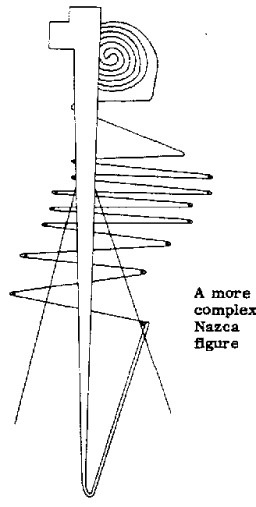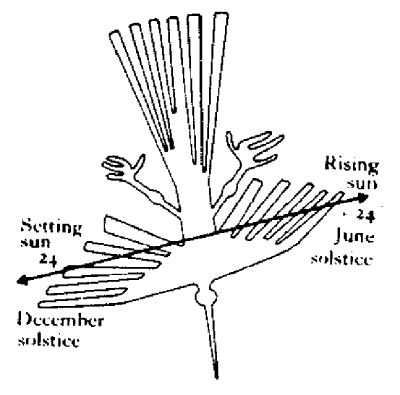 |
Science Frontiers ONLINE No. 28: Jul-Aug 1983 |
|
|
Nazca Figures Duplicated
 Sensational literature makes much of the huge geometrical figures and outlines of animals etched into the high Peruvian tablelands. Most of these figures and lines are so large that one can fully appreciate them only from the air. This fact has led some writers to invoke ancient astronauts and even ancient Peruvian balloon technology. The fact of the matter is that archeological evidence is pretty convincing that the Nazca Indians constructed the lines about 500 A.D. But did they have extraterrestrial help or use some advanced technology?
Sensational literature makes much of the huge geometrical figures and outlines of animals etched into the high Peruvian tablelands. Most of these figures and lines are so large that one can fully appreciate them only from the air. This fact has led some writers to invoke ancient astronauts and even ancient Peruvian balloon technology. The fact of the matter is that archeological evidence is pretty convincing that the Nazca Indians constructed the lines about 500 A.D. But did they have extraterrestrial help or use some advanced technology?
The author of the subject article, with the help of a few friends, answered these questions quite convincingly -- in the negative -- in the summer of 1982. Using sticks and string, they scaled up a small copy of the famous Nazca "condor" into a 440-foot replica of the real thing on a Kentucky landfill. The scaling up involved no high technology; in fact, even angular measurements were avoided. Instead of removing stones to make the lines, as the Nazcans did, lime was applied. The whole figure was laid out and limed in just a few man-hours. Then, from an aircraft at 1,000 feet, photos were taken. Lo and behold, a very convincing replica of the Nazca condor appeared on the prints. Still unanswered, though, is why anyone would want to make such huge drawings.
(Nickell, Joe; "The Nazca Drawings Revisited: Creation of a Full-Sized Duplicate," Skeptical Inquirer, 7:36, Spring 1983.)
Comment. While some of the animal figures and arrays of lines may have had ritual or archeoastronomical purposes, others seem too complex for such simple explanations. Of course, to the Nazca Indians the purpose was probably simple and obvious.
Reference. Much more on the Nazca lines appears in our Handbook: Ancient Man. This book is described here.
